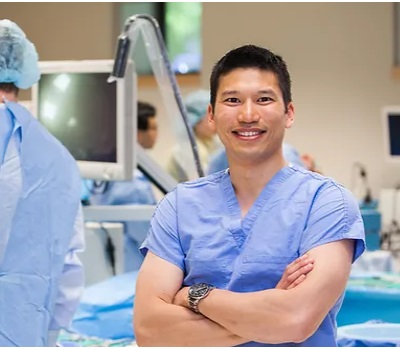Innovative shoulder surgery technique created in Halifax

Dr. Ivan Wong, orthopedic surgeon specializing in sports medicine and trauma surgery
By Michele Charlton
A groundbreaking surgical innovation developed in Halifax to treat shoulder instability was profiled during a live broadcast to international conference participants in mid-December 2021.
A surgeon from Nova Scotia Health has developed a new portal that allows for the placement of bone grafts to help augment bone loss in the shoulder joint, while avoiding the complications associated with the surgical approach that is commonly used in shoulder surgeries.
Dr. Ivan Wong, an orthopedic surgeon who specializes in sports medicine and trauma surgery, provided a live demonstration of the Nova Scotia developed surgical solution during the 2021 Orthopaedic Summit on Tuesday, December 14.
The shoulder has the greatest range of motion of any major joint in the human body, but this degree of mobility also leaves the joint vulnerable to dislocation and instability. Not only can these issues limit the range of movement, but they can also require multiple hospital visits for treatment and surgical procedures to prevent further dislocations.
Two surgical techniques have typically been used to treat shoulder instability:
- The Bankart repair addresses soft tissue within the shoulder, but patients who have significant bone loss did not have ideal outcomes following this treatment.
- The Latarjet technique aims to restore bone loss in patients using their own tissue, typically from their shoulder blade. While this surgery was initially deemed to be effective, there are many complications associated with the procedure, including neurovascular issues arising from harvesting the patient’s own bone.
The new technique developed by Dr. Wong, ‘Arthroscopic Anatomic Glenoid Reconstruction’ or AAGR, has been shown to offer patients improved outcomes and low rates of recurrent shoulder dislocations. In addition, recovery is easier than other procedures, and involves wearing a sling for only a couple of weeks.
By demonstrating this new technique to an international audience, Dr. Wong is hoping to encourage more surgeons who are interested in trying this new method. He was the only Canadian to be showcased, in this manner, at this conference.
Prior to the surgery, the patient was “very excited to be a part of the innovative surgical procedure” and is “confident the surgery will improve [her] quality of life by reducing if not eliminating [her] shoulder dislocations.”
“The surgery went well, and the patient will recover and get back to her usual lifestyle in about 6 to 9 months’ time” added Dr. Wong following the success of the surgery during the conference. “This may be the standard to treat patients with shoulder instability in the future.”








